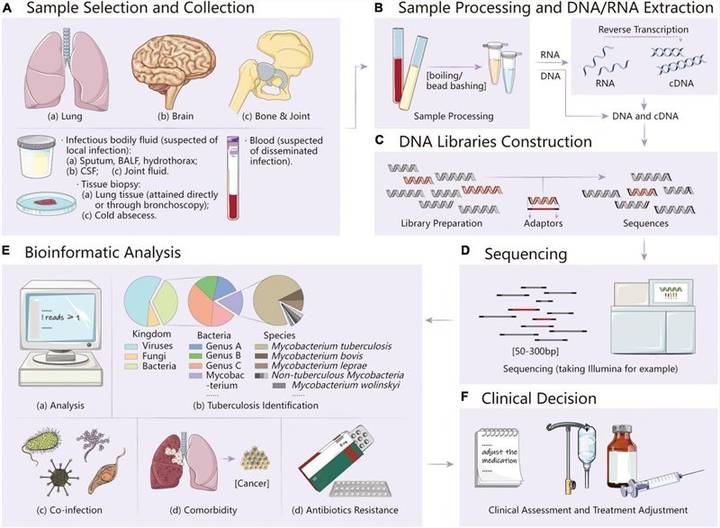- Resource
- Applications
- Metagenomic Next-Generation Sequencing (mNGS): How does it work in Pathogen Detection
Metagenomic Next-Generation Sequencing (mNGS): How does it work in Pathogen Detection
What is Metagenomic Next Generation Sequencing?
Metagenomic next generation sequencing (mNGS) is a cutting-edge technology that has revolutionized our ability to study complex microbial communities. This technique enables the simultaneous sequencing of DNA from multiple organisms in a sample, without the need for isolation or cultivation of individual organisms. As a result, mNGS has become an invaluable tool for microbiologists, enabling them to study the diversity and function of microbial communities in a variety of environments.
CD Genomics offers targeted metagenomics kits based on mNGS, accelerating discoveries in metagenomics, functional genomics, evolutionary biology, public health, and infectious diseases.
Workflow of mNGS
The process of pathogenic microorganism high-throughput detection mainly includes sample pre-treatment, nucleic acid extraction, library construction, sequencing and data analysis. Bioinformatics analysis includes data quality control, host sequence removal, microbial species comparison and identification, drug resistance gene and virulence gene analysis, etc.
Workflow of mNGS

Bioinformatics Analysis in mNGS
Bioinformatics analysis is the final part of pathogenic microorganism detection by mNGS. However, errors can be introduced during data analysis, leading to false negative or false positive results. An overall assessment should first be made by the amount of sequencing data (at least 10 Mb) and sequence quality (Q20/Q30) of each sample. Subsequently, Trimomatica or Fastp software is generally used to remove splices, low-quality sequences, low-complexity sequences, and short read-length sequences to obtain high-quality sequences that can be used for downstream analysis.
Application of mNGS in Pathogen Identification
Infectious diseases are the leading cause of human morbidity and mortality worldwide. Multiple types of microorganisms may contribute to clinically complex infectious diseases, and the relatively narrow spectrum of pathogens that can be identified by traditional methods poses a significant challenge for rapid and accurate pathogen diagnosis. Traditional culture, serological tests, and nucleic acid amplification tests are time-consuming and prone to miss detection, which can easily lead to clinical underdiagnosis or misdiagnosis, even more in turn leading to the misuse of empirical broad-spectrum antibiotics. In contrast, mNGS enables rapid, accurate and comprehensive identification of bacteria, fungi, viruses and parasites directly from a variety of specimens. In particular, it is significantly superior to culture methods in identifying taxa such as mycobacteria, anaerobes, atypical pathogens and viruses.
mNGS can be widely used to identify the pathogens of different systemic infections such as bloodstream infections, central nervous system infections, respiratory infections, bone and joint infections, urinary tract infections, and digestive system infections. It helps to identify the pathogens of pulmonary infections rapidly and accurately, especially for the treatment of critically ill patients and those with mixed infections. For respiratory infectious diseases, the sensitivity of mNGS for the detection of caustic bacteria (such as Mycobacterium tuberculosis, nontuberculosis, Nocardia, Actinomyces, anaerobes, etc.) and viruses is better or not inferior to that of traditional detection methods.
What Are the Challenges of Metagenomic Next Generation Sequencing?
Despite the great role of mNGS in the diagnosis of infectious diseases, there are still some technical challenges that need to be overcome.
a) How to minimize the impact of host nucleic acids?
Methods to remove host DNA and enrich pathogenic microorganisms include the following two main categories: (i) removal of host cells based on the difference in size between host and microbial cells, such as centrifugation and filtration; (ii) selective lysis of host cells followed by treatment with enzymes or chemical reagents to remove the exposed DNA.
b) How to improve the efficiency of intracellular microbial and fungal detection?
The detection efficiency of mNGS for intracellular bacteria such as fungi and tuberculosis is lower than that of other microorganisms. Therefore, effective lysis of the cell walls of fungi and intracellular bacteria can help improve detection efficiency. The main methods currently used for cell wall breaking include physical breaking (heating, enzyme digestion), mechanical breaking (ultrasound, magnetic beads), and chemical breaking.
c) How to effectively detect drug resistance and virulence genes?
Currently, the short read length of second-generation sequencing, the insufficient amount of effective sequencing generated (non-human source), and the complex and diverse drug resistance mechanisms hinder the application of metagenomic next-generation sequencing for drug resistance gene and virulence gene detection. Meanwhile, the characteristics of long read length, high throughput and real-time sequencing of the long-read sequencing technology determine its broad prospect of application in the field of drug resistance gene and virulence gene detection.
d) More comprehensive and complete databases help microbial annotation, and the following factors need to be considered for the selection of microbial databases.
i) Incomplete reference sequences for rare pathogens or emerging strains of pathogens.
ii) Reference databases with species preferences.
iii) Genetic similarity of pathogens, etc.
CD Genomics aims to provide clients with comprehensive pathogen research and development solutions to help them rapidly and accurately identify pathogens and understand their genomic characteristics for better disease prevention, transmission, and control research. Contact us for more information.
Reference:
- Li Y, Jiao M, Liu Y, et al. Application of Metagenomic Next-Generation Sequencing in Mycobacterium tuberculosis Infection. Frontiers in Medicine, 2022, 9: 802719.
* For Research Use Only. Not for use in diagnostic procedures.
